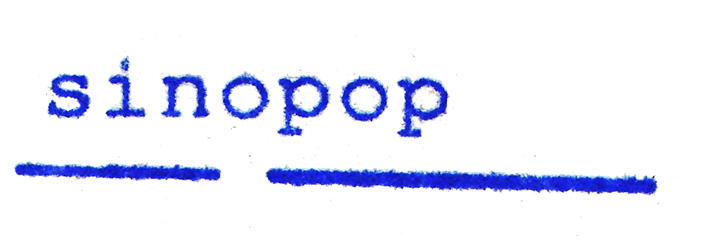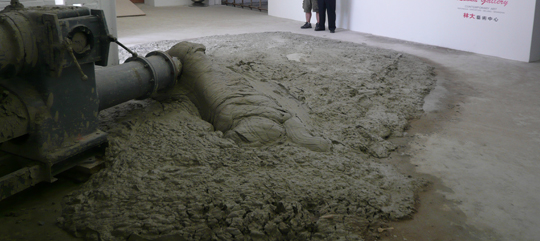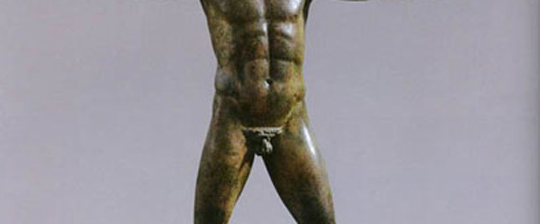The “O” Shirt from Zhang Da
In a hidden corner in 798, lies a surprise awaiting fans of minimalist fashion, playful irony and small, independent fashion labels …
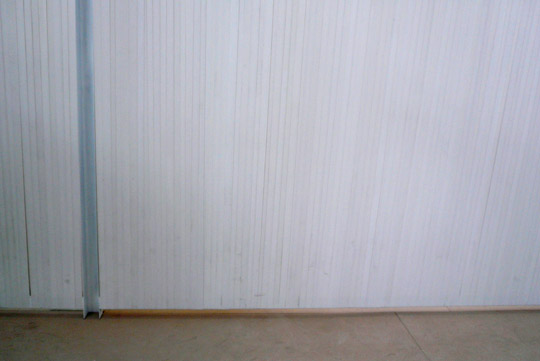
I was baffled on first site, and walked the full circumference of the “white cube” before realizing…
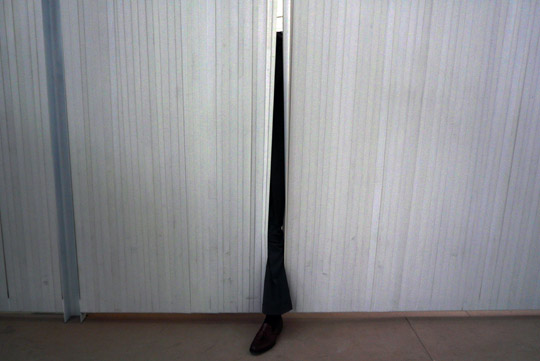
Inside the clever white elastic “cube” are six more partitions, all filled with Zhang Da’s designs for his 2008 line. These simple designs are flattering on many body types, and a refreshingly original take on androgny; he takes the non-differentiation of sexes to a new level–up can be down, inside can be out. It can all be comfortably stylish (and affordable, the few price tags spotted were below 500 RMB).
Zhang Da has pioneered the response to the “T” Shirt: the O Shirt. You can see the O Shirt and other designs at this temporary store. (Keeping you in suspense…) Information and photos below >>>>>>>>>>>>>>>>>>>>>>>>>>>>>>>>>>>>>> Read the rest of this entry »
Paper Schools in Cheng Du
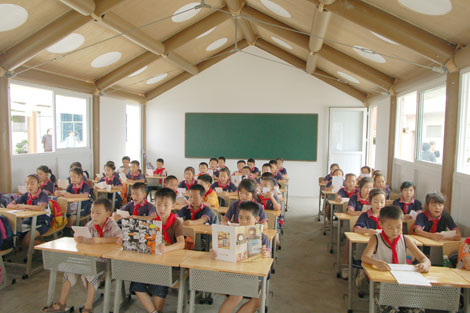
Who said that temporary shelters can’t be attractive? Japanese architect Shigeru Ban’s research studio banlab built these temporary schools for children in Cheng Du last September, and PingMag features them in an interview with the project director, Wataru Inoue. See more photos of the design and installation process on the Ping Mag site, and enjoy the friendly cooperation between Japanese and Chinese architects and students.
Read the interview and see more images here
For more PingMag architectural “MADness,” read an interview with MAD’s Ma Yansong
Ni Haifeng & Zhang Peili: common threads in a manufacturing nation?
In Shenzhen’s OCT Contemporary Art Terminal , Zhang Peili installed his third solo of 2008, again featuring remains, Mute. In this “scene” (a “new form of art” that Zhang Peili has been developing, he contrasts the real and the perceived, the static and the dynamic, over the abandoned reckage of manufacturing sewing tables and two parallel video projections of people working in the exact same space.
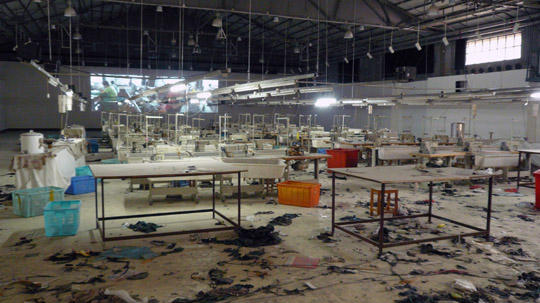
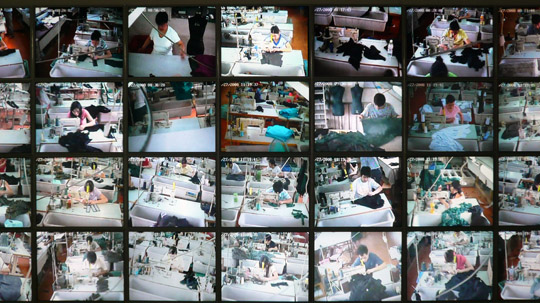
Concurrently, at Beijing’s JoyArt Space, Ni Haifeng (artist site) employs similar on-site tailors who shredded, then reconstruct more than 10 tons of reclaimed fabric in Para Production. The result is a wall sculpture that reaches to the ceiling; remains are scattered across the space. The show is curated by Pauline Yao, see more photos of the show and its installation at her site.
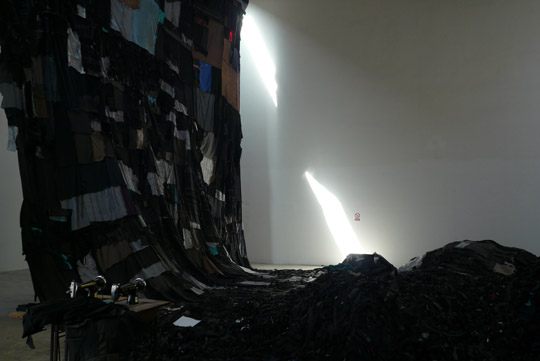
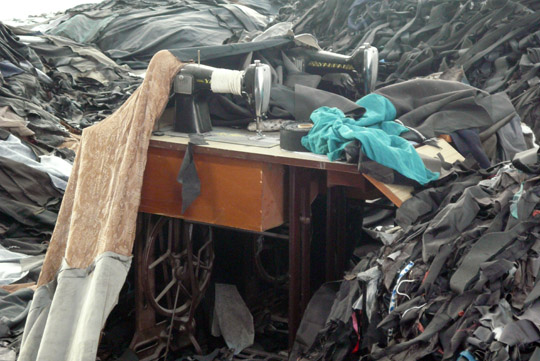
Although these two artists have different aims, the similarity of their means is outstanding. Both employ anonymous, live performers in the installation of, and integrally in the manufacture of their works. Both use the reconstructing, reorganizing and recontextualizing of materials, Ni Haifeng working with the fabric itself, and Zhang Peili with video clips that he garnered from a performance within the space. Both display their final product (fabric-sculpture, video montage) amidst the un-edited ruins of its production process.
For more “common threads” and variations on this theme, please reference Zheng Guogu’s Factory exhibition, January 2008 at Beijing’s Tang Contemporary.
More exhibition scenes below . . .
On Jubilee Street, Hong Kong milk tea
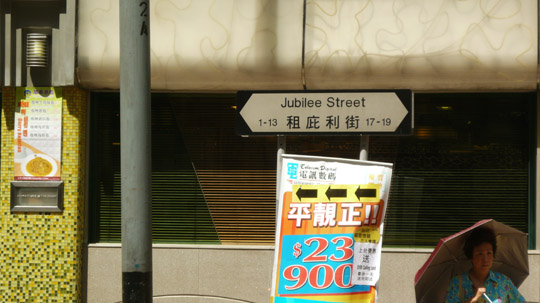
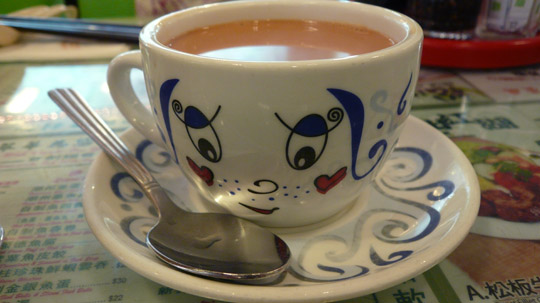
Pierre Huber’s Prize Exhibition
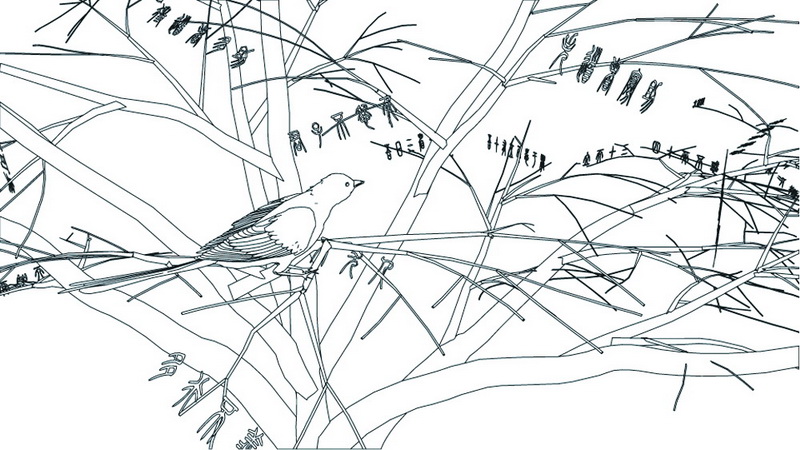
陈春
Chen Chun
《鸟之死》The Bird’s Death
动画 Animation
7 ′ 30 ″ 2008
Ten students from the New Media Art Department of the China Art Academy (Zhejiang) display their work in 798’s T-Space. These students were vying for the “Pierre Huber Creation Prize”scholarship, a prize furthering creativity in the fine arts that was established last year in 2007. The winner, Li Ming, took the prize with a video of a crude backhoe combing a young woman’s tangled hair. She sits in the rubble of a destroyed home.
The show is an interesting focus on some of China’s young talent, and it is nice to see perspectives from outside of Beijing. Still, I was surprised to see how many of these works were extensions of common tropes in Chinese art: photo series (featuring migrant laborers, people in their underwear) and the “24 video documenting absolute nothing while I sit in my dirty room for days at a time”. I have seen several variations on this theme on display in Beijing over the last 6 months alone.
I was particularly moved by Li Fuchun’s (a runner up) helium balloons lifting a board on which was scattered the creamated remains of a human. That work touched a nerve and tapped into a sense of the ethereal, almost reaching a state of expression that can’t quite be put into words, something that I consider a higher form of contemporary art. Unfortunately, it was stuck in a corner of the stairway by the time I encountered it. Wang Liang sat at his loom weaving a black and white pattern out of a random generated code of 1 and 0’s, which I also enjoyed, but the process and result seemed too similar to Lu Qing’s long hand-painted silk for me to feel comfortable.
Even though the majority of the works had a witty sense of academia hovering about them, all were wonderfully executed. Their installation also put many local galleries to shame. T Space has done a great job at working for furthering the definition of art. This student exhibition was also a great step for what is trying to be a “non-profit” space in Beijing. Congrats to to Mr. Huber, who has solidified his name as legend in Chinese contemporary arts. The next best thing to opening an enormous space named after you, is to commemorate yourself with a prize.
Subtlety at Platform China
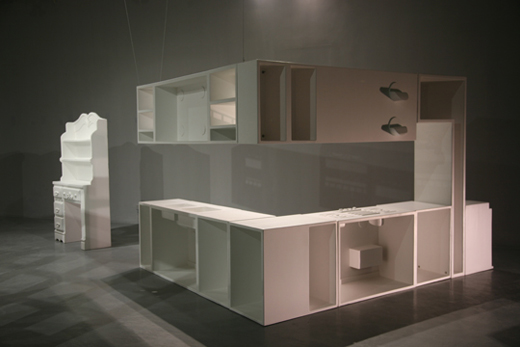
PLATFORM CHINA|站台空间
No. 319-1 East End Art (A), CaoChangDi Village, Chaoyang District|朝阳区草场地村319号艺术东区内
August 30-October 12
Chinese culture is steeped in delicate intimations sometimes so slight they can be easily missed. In “Subtlety,” curator Karen Smith presents a thoughtful selection of nine Chinese artists—of divergent generations, media, and creative thought processes—who demonstrate this historical refinement. Wang Wei creates site-specific installations that transform their exhibition spaces. For this exhibition, he has enlarged a dozen pieces of the tiny furniture used in real estate mock-ups. These life-size wardrobes and kitchen sets have an odd effect on the space, causing double takes. The artificiality of these stunningly white wooden sculptures is enhanced by their epoxy-resin edges, which give them the appearance of having been pulled from plastic molds. Hu Xiaoyuan and Qiu Xiaofei, who are a couple, present independent works in adjacent rooms; each artist uses a combination of found objects and conventional artistic media to evoke nostalgia. For Permanent Address, 2008, Qiu has assembled from flea-market goods a complete domicile, its corridor entrance flanked by towers of discarded electronics, as well as rice cookers realistically re-created in painted wood. Hu’s Summer Solstice, 2008, is more symbolist and organic: a battered, lift-top school desk is filled with cicada husks; everyday objects fashioned from coarse papier-mâché are displayed on small wooden shelves above it. From the open drawer of the desk, a roll of blank paper spills out onto the floor. The cicadas represent years of gestation in a harsh, survival-of-the-fittest educational system that the surrounding desk and school supplies intimate. In another room, Jia Aili, a young painter known for barren landscapes and ominous figures wearing gas masks, presents a video filmed out the window of a train. Using charcoal pencil, he has covered the nearly sixteen-foot-high adjacent wall with realistic cracks, flimsy nightgowns, and blank canvases. An otherworldly light casts shadows on this crowded wall of nonexistent, two-dimensional objects in the dim room, and a trademark demonic gas mask stares at viewers from its center.
— Lee Ambrozy
read more critics’ picks at artforum.com
Looking For Me: FOUND
Some of us look forever, others never seek––perhaps they’re already found “ME.” New September 2008 publication is a compilation of short texts and artwork images documenting China’s new generation of “Post 70s” artists. Included within are 30 artists, each artist includes a short introduction, three full pages of color images, and up-to-date artist resumes, there is even a photograph of each artist, in the old school, i.d. photo style.
These artists included are among the most outstanding of their generation, they represent Mainland China’s up-and-coming talent in the visual arts. Although often called the “Post 70s” generation, the artists here are mostly born after 1975. The book is a compliment to the exhibition of the same name, curated by Fang Fang (art director of Star Gallery and 2006 exhibition “Naughty Kids”), but is meant to stand on its own, and become a resource tool for those interested in this younger generation of artists, a browsing book.
If you’re like everyone else I know, you’re thinking: What does the name mean?
After spending a summer on this book, researching these artists, writing texts, translating and pondering the very same question I can only say: It means what ever you want it to. Whatever looking for you might entail. May you find it within!
Artists: Ouyang Chun / Li Jikai / Wei Jia / Qin Qi / Huang Yuxing / Xiong Yu / Wen Ling / Wang Guangle / Liu Ding / Li Hui / Qiu Jiongjiong / Song Kun / Wang Yaqiang / Liang Yuanwei / Cao Fei / Wang Yifan / Li Chaoxiong / Chen Ke / Xu Maomao / Jia Aili / Gao Yu / Li Qing / Qiu Xin / Wen Chuan / Yan Cong / Ha Migua / Chen Fei / Jin Nv / unmask
Book design: Liu Zhizhi MEWE
Authors: Lee Ambrozy / Jing Xiaomeng / Gong Jian / Huang Shan / Helen Li / Pauline J Yao / Chang Chang
“HANGING IN THE SKY, DRIFTING ON THE SURFACE” and spilling on the floor
Sui Jianguo’s piece above, Untitled, spills into the nave at Linda Gallery’s inaugural exhibition in 798, “HANGING IN THE SKY, DRIFTING ON THE SURFACE.” The Chinese title expresses a similar sentiment of this piece more nicely, with …bu neng kaojin (cannot approach). The exhibition was curated by Zhu Qi, and features some quite respectable artists, Zhan Wang 展望, Wang Jianwei 汪建伟, Gao Lei 高磊, Wang Luyan 王鲁炎, and others I feel particular repulsion to, aka (Zhang Peng 张鹏).
This latest Sui Jianguo installation truly fooled me; its haphazard placement in what could very possibly be a half-finished gallery almost makes it look like management had a little problem with concrete machine. One can’t help but wonder, is this work masking a more cynical implication, or perhaps hinting at exhibition fatigue?
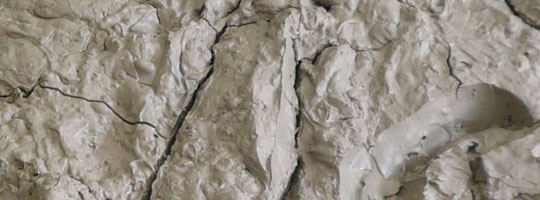
Breaking Olympic News: Ancient Greeks Had Small Genitalia!
These past two weeks, every communication included something along the lines of “How are the Olympics,” or “hope you’re surviving the Olympics”. The answer: smothering, and just barely.
Now that they have concluded, I feel that ominous burden slowly melting from my psyche, and I realize that I was truly not “coping well” with the games. I was instead lying low, playing dead, unable to watch or even comment on this historic event. Instead, I escaped the steamy red and yellow fervor emanating from the Bird’s Nest stadium by flying off to Yunnan province, a necessary act of “self-protection” (a Chinese pun on “avoiding the Olympics” and “contraception”) but the fervor pursued.
The NYT headlines mocked me in my inbox, conflicting and paradoxical news “angles” from American and Chinese news sources accumulated, champions wept or chomped on their lead-tinged gold medals over the endless highlights montages that were repeating on televisions across China, on every CCTV station, in the airport, in the bus station, waiting for elevators…
From 29, 49, to 51 gold medals––this news tracked me down even at 2000+ meters above sea level. Perhaps it wasn’t altitude sickness at all that left me vomiting in the bathroom. The record-breaking conclusion of the games was a victory for the Chinese spirit, for which I extend my true congratulations.
After returning to Beijing, and while browsing one of my favorite stress-relieving Chinglish sites, the Century Online China Art Networks, my “unprotected” eyes were despoiled by an unusual, but seemingly Olympics related headline: “Why does so much ancient Greek art feature males with small genitalia.” An English article posted on August 22, 2008 and signed “CL2000.com.” Here, among Beijing exhibition reviews, a feature on Buddhist sand mandalas, and a piece on the Jewish Museum, was this seemingly out of place reportage on the heft and quality of ancient Greek genitals as evidenced in statuary. Read the rest of this entry »
Diary of the Spectacle
by Lee Ambrozy (post from ArtReview.com)
On a day of orgasmic auspiciousness in China, 08/08/08, crowds piled into bars, parks, official ‘fanzones’ outside the Olympic stadium and the old Workers’ stadium, and along Beijing’s ancient north-south axis to watch the opening ceremony collectively on big screens and get the best view of Cai Guo-Qiang’s city-wide fireworks display (they would be the only ones to see the real real fireworks, rather than the computer graphics that appeared on TV). But far removed from these displays of patriotism, and perhaps soured by an already suffocating ‘Olympic spirit’, most of us in Beijing’s artworld chose to scrutinize the ceremonies from our couches.
Still, with cultural giants Zhang Yimou (celebrated director of House of Flying Daggers (2004)) and ace fireworker Cai Guo-Qiang, fresh from his huge exhibition at the New York Guggenheim, behind this production, our expectations were almost as high as the $300 million budget. Responses from the intellectual and creative communities in China were quick and overwhelmingly negative. On his blog, Ai Weiwei, design consultant on the Bird’s Nest and now an outspoken critic of the government in the run up to the games, called it ‘an encyclopedic display of a spiritual consciousness fallen into enemy hands’.
The Chinese know how to exploit manpower, and communism loves its gala performances. Zhang Yimou seemed to be borrowing the techniques of North Korea’s Arirang Mass Games (recently photographed by Andreas Gursky): using people-as-pixels to form staggering, intimidatingly huge collective images in which the individual is subsumed entirely, yet still crucial to the perfection of the big picture.
continue reading here
